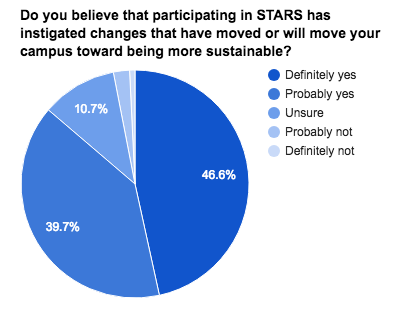Why Participate in STARS?
(All quotations are from STARS participants)
1. Gain international recognition for your sustainability efforts
To date, more than more than 420 higher education institutions have earned a STARS Bronze, Silver, Gold or Platinum rating or achieved recognition as a STARS Reporter.
2. Generate new ideas
Whether your institution is just starting out or an established leader in sustainability, STARS will help you identify best practices that you can implement locally.
3. Engage your community
STARS is a great organizing tool to engage students, staff, faculty, and administrators in building a culture of sustainability on campus and beyond.
“It has opened lines of communication and has expanded sustainability understanding across campus.”
4. Create a baseline for continuous improvement
STARS will allow you to comprehensively measure your institution’s current sustainability performance and assess your progress, both internally and in comparison to peer institutions.
“The STARS rating gave our institution something to celebrate, and the credits provided both food for thought in terms of what goals are achievable in our current context and what we might try to achieve in the long term.”
“We now have more of a common vocabulary to talk about STARS-related topics. We also know where we need to go to improve in each of the categories. And because we are working with STARS, we have greater validity with others to get some of these other improvements developed and implemented”.
5. Inform strategic planning and budgeting
STARS can serve as a framework to help integrate sustainability into your institution’s planning and development efforts.
“STARS gives a certain amount of legitimacy to the resources [the institution] has put to sustainability, it provides positive reinforcement for efforts already underway and it shines a light on the whole spectrum of sustainability work happening on campus, all three of which will give institutional weight to sustainability moving forward, in our strategic planning process and in the budgeting process with a new office of sustainability.”
6. Integrate sustainability into the curriculum
Many institutions include STARS in sustainability courses and co-curricular programming.
7. Make real progress toward sustainability
More than 86% of participants report that STARS has instigated changes that have moved or will move their institutions toward being more sustainable.

8. Be part of a global community of STARS Institutions
More than 800 institutions on six continents are using the STARS Reporting Tool to measure their sustainability performance, making STARS the most widely recognized standard for higher education sustainability in the world.
There are two levels of access to the STARS Reporting Tool, making it easy for any higher education institution to get started today.
